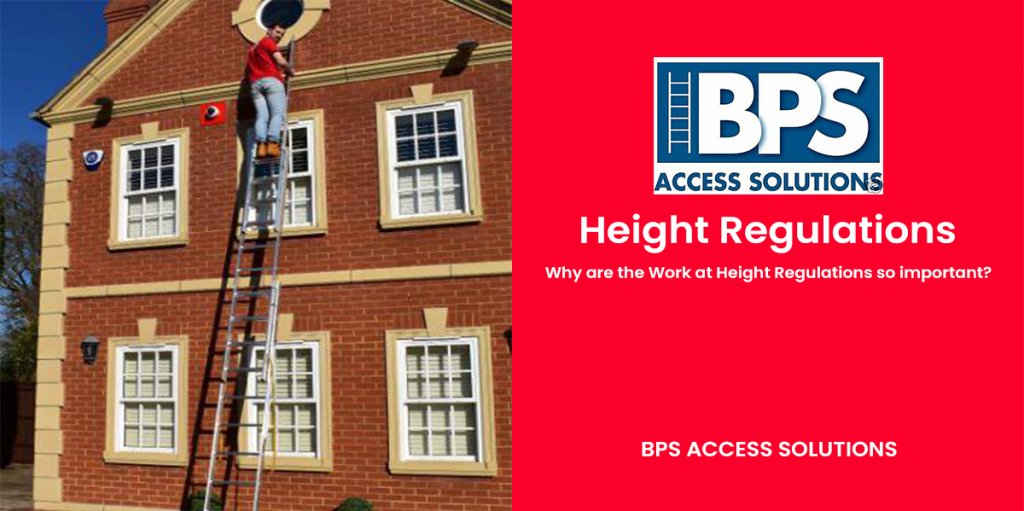Why are the Work at Height Regulations so important?
The Work at Height Regulations 2005 are a piece of cornerstone regulatory legislature which set out a number of essential rules for workers and businesses which use height access equipment at work. The Work at Height Regulations 2005 contain detailed guidelines which cover factors like working surfaces, the type of ladders and height access equipment which can be used in various circumstances and the amount of time workers should spend on this equipment before taking a break.
Sometimes we hear customers asking about the Work at Height Regulations and questioning whether they are really that important. The short answer is yes, they are. Failure to plan ahead before using height access equipment on a worksite can result in significant fines if an accident does occur. The financial penalties from breaking these laws, combined with the potential for massive civil compensation claims mean that all businesses should be cautious of non-compliance.
But the most important consideration of all to bear in mind is the potential for severe injury or even death to workers and bystanders if an accident involving a fall from height does occur. In 2018/2019, falls from height were the single largest cause of fatal workplace injuries in the UK. Falls from height have been one of the top causes of injury and death at work for many years. Despite increased regulation and precautions to prevent injury when working at height, ladders and other types of height access equipment are evidently still very dangerous.
It’s now 15 years since the Work at Height Regulations 2005 were introduced, meaning that almost all employers should be aware of their guidelines. Just in case you’re not, we’ll run through a few of the key points below.
Important safety precautions
Planning ahead is one of the key precautions outlined in the Work at Height Regulations 2005. Before any work which may involve someone working at height is carried out, the company or people supervising the project must carry out a thorough assessment of potential risks and hazards. A properly conducted risk assessment will take note of factors like weather conditions, potential hazards on the work site, whether or not appropriate equipment is being used and whether or not bystanders are present.
The term ‘work at height’ applies to all the obvious situations, as well as a few which you may not immediately think of. For example, a work site where workers could fall through a fragile surface or into a concealed hole in the ground. Even though they are usually no more than a few feet off the ground, work involving step ladders does count as working at height because they are still high enough to cause significant injury.
Thorough checks of all equipment before it is used is another fundamental rule outlined in the Work at Height Regulations 2005. Ladders, scaffold towers and all other equipment used in work at height should be checked for damaged or worn components each time it is set up. Certain components are much more prone to wear and tear than others, meaning they should be monitored extra closely. Additionally, it is vital that height access equipment is only used within manufacturer guidelines. The maximum weight limit of a ladder should never be exceeded and it should always only be used in suitable conditions as outlined by the manufacturer.
Finally, the other main safety precaution outlined in the Work at Height Regulations 2005 is how to use height access equipment safely. There are certain precautions workers should always take, such as maintaining three points of contact with the ladder at all times and wearing appropriate safety gear. Then there are certain things you should never do, such as overstretching or mishandling tools while on a ladder.
Everybody’s responsibility
While it is the employers or owners of a site which are ultimately responsible for ensuring that the Work at Height Regulations 2005 are complied with, the workers also have a responsibility to make sure they are working safely. It’s not just the worker on the ladder that could be severely injured or killed as a result of an accident. Bystanders can easily be caught up if precautions are not followed.
It is also everybody’s responsibility to report damaged or outdated equipment, unsafe work practices and violation of rules if they see them. If someone dies or is severely injured as a result of an accident which could have been prevented, hefty fines or even criminal charges could well be on the cards. You may have thought the Work at Height Regulations 2005 were just excessive health and safety guidelines, but they serve a very important purpose when it comes to protecting workers, businesses and the public from harm. If you would like to know more about the Work at Height Guidelines 2005, visit the Health and Safety Executive’s website here.
If you would like to know more about the range of height access solutions we offer, please get in touch.
No related posts.



